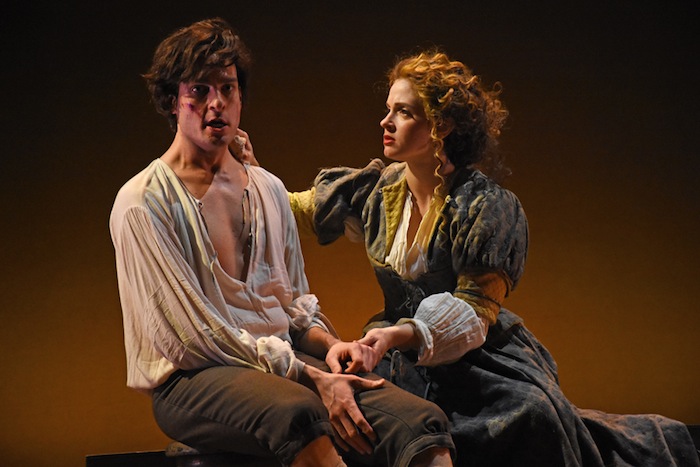Carlisle Floyd’s “Prince of Players,” a gently compelling opera of gender issues at LOTNY

Michael Kelly and Maeve Hoglund in Carlisle Floyd’s “Prince of Players” at the Little Opera Theatre of NY. Photo: Tina Buckman
At a time when issues of gender are front-and-center in the public arena, along comes 90-year-old composer Carlisle Floyd to weigh in skillfully—and touchingly—on the subject. Commissioned by the Houston Grand Opera, Prince of Players had its world premiere in March 2016, and since that time Floyd has made revisions, prior to this New York debut at the Kaye Playhouse by The Little Opera Theatre of NY (officially “the little OPERA theatre of ny”).
As in many operas, Shakespeare is the axis, in this case Edward Kynaston (1640-1712), an actor renowned for performing female roles in the Bard’s plays. Samuel Pepys (winningly played by Hunter Hoffman) reportedly called Kynaston “the loveliest lady I ever saw in my life.” When King Charles II decreed that males playing females were forbidden, and that female actors could officially enter the field, Kynaston had to ponder his future as an actor in a reborn landscape—similar to the plight of silent film actors at the dawn of sound.
Floyd uses the story to expound on acting and artifice, on romance and culture (the setting is 1661 Restoration London), on sexuality and convention. His libretto is based on Jeffrey Hatcher’s play, Compleat Female Stage Beauty (later the 2004 film, Stage Beauty), and makes often engrossing viewing simply because of the plot. Behind Kynaston’s public face, Floyd fills in very human details.
Like the composer’s earlier operas, such as Susannah (1955) and Of Mice and Men (1970), his language is primarily tonal, with astutely inserted dissonances, and a fine instinct for vocal writing that shows off singers at their best. In the final scene, a mirror of the opening one, Floyd gives the entire cast a chance to soar.
As the title character, Michael Kelly showed a versatile baritone, first in scenes requiring him to portray a woman singing and later, a man. Whether using fluttering hand motions (as Desdemona in Othello), revealing embarrassment when two women wish “an inspection” of his private parts, or participating in two sexual interludes (discreetly managed by lighting designer Nick Solyom), Kelly’s sensitive acting chops were impressive.
As Margaret, the woman who covets the chance to sing onstage, soprano Maeve Högland had some of the evening’s most affecting lines, shrewdly saving some of her best moments for the final scenes. When she quietly sang to Kynaston, “I know you can’t feel the same way,” the sadness rippled through the theater.
It was a pleasure to hear strong voices in a relatively intimate space (despite the Kaye’s dry acoustic). Tenor Marc Schreiner made an imposing turn as Charles II, and Ron Lloyd lent a supple baritone to the role of Sir Thomas Betterton. As Lady Meresvale, Elizabeth Pojanowski showed a formidable mezzo, and soprano Heather Hill had a luscious turn as Miss Frayn. And tenor Bray Wilkins, playing Villiers—the Duke with a secret—gave one of the most piercing scenes later in the opera.
As Samuel Pepys, who introduces the opening scene (from Shakespeare’s Othello, when Desdemona is killed), Hunter Hoffman displayed charm and wit. Adding to his handsome tenor, Raùl Melo gave appropriate surprise at some of the goings-on, and soprano Sharin Apostolou was appealing as Nell Gwynn. Completing the excellent, alert cast were Daniel Klein, Oswaldo Iraheta, Sahoko Sato Timpone, Kyle Guglielmo, Robert Balonek, and Elizabeth Novella.
Late in the opera, veteran Jane Shaulis was delightful as brothel owner Mistress Revels (sporting a bulbous creation by wig designer Rachel Padula Shufelt), who led the cast in the bawdy “No Balls at All,” worthy of an outtake from Sweeney Todd.
Conductor Richard Cordova adroitly led the 31-piece orchestra with ease and commitment, despite a bit of first-night raggedness. Director Philip Schneidman (LOTNY’s artistic director) made good use of the spare scaffolding and small balconies designed by Neil Patel and Cate McCrea.
Choreographer Katie Rose McLaughlin had her “moment” with a brief, formal dance, which Floyd wrote to evoke the period, but with gently altered rhythmic interest, adding an extra beat here and there. And without the budget commanded by larger houses, costume designer Lara De Bruijn successfully captured Restoration style.
During the ovations, the composer—helped to the foot of the stage by a friend—turned to acknowledge the audience. Given his age, it seems unlikely Floyd will do another opera, but in any case, this moving effort will rank as a fitting finale.
Prince of Players continues through Sunday at the Kaye Playhouse at Hunter College. (Performances on Friday and Sunday have a second cast.) hunter.cuny.edu/kayeplayhouse/calendar.



Posted Feb 24, 2017 at 5:56 pm by Rafael
Lovely review!